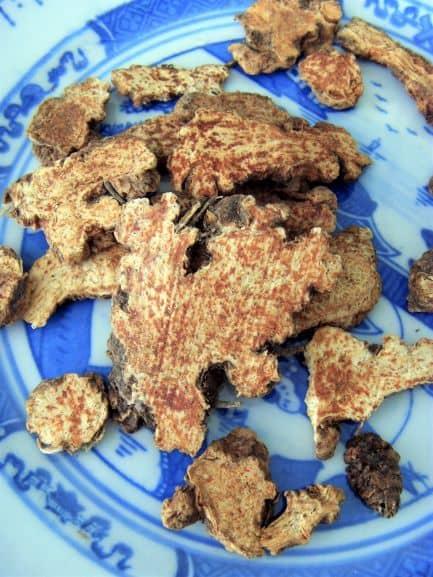Rhizoma Atractylodis
- Name
- Origin
- Where Does It Grow?
- Nature and Flavor
- Identified Active Components / Major Chemical Constituents
- Drug Actions in TCM
- Traditional Uses in TCM
- Pharmacological Actions
- Toxicology
- Administration and Dosage
- Adverse Effect, Side Effects and Cautions
- References
Name
Latin Name: Rhizoma Atractylodis
Common Name: Atractylodes rhizome
Scientific Name: Atractylodes lancea (Thunb.) DC. / Atractylodes chinensis (DC.) Koidz.
Chinese Name: 蒼朮
Pinyin Name: cang zhu
Origin
The dry tuber of Atractylodes lancea (Thunb.) DC., or Atractylodes chinensis (DC.) Koidz., a plant of the Compositate family.1
Where Does It Grow?
Atractylodes lancea (Thunb.) DC. is mainly produced in Jiangsu, Hubei, and Henan provinces in China, others like Zhejiang, Anhui, and Jiangxi are also produced. The supplies from Jiangsu and Henan have better quality, but the production in Hubei is the largest. Atractylodes chinensis (DC.) Koidz. is mainly produced in Hebei, Shanxi, and Shensi provinces, other places like Liaoning, Inner Mongolia and Gansu are also produced. Nowadays, the herb is cultivated.1,5,6
Nature and Flavor
Atractylodes rhizome is warm in nature, pungent and bitter in flavor, and mainly manifests its therapeutic actions in the spleen, stomach and liver meridians.7
Identified Active Components / Major Chemical Constituents

Drug Actions in TCM
Atractylodes rhizome dry dampness, enhances spleen, expels wind and dampness, and sharpens vision.7Traditional Uses in TCM
Atractylodes rhizome promotes eye health
Pharmacological Actions
Toxicology
Administration and Dosage
For decoction, the suggested dosage for atractylodes rhizome is 3〜9g, or in powder and pill preparations. The maximum dosage is 9〜15g, if necessary.4
Adverse Effect, Side Effects and Cautions
References
- Li Jiashi (editor-in-chief), Chinese Medicine Identification, Shanghai Scientific and Technical Publishers, 2000-2.
- Lui Daiquan (editor-in-chief), Chinese Herbal Medicine, Shanghai Scientific and Technical Publishers, 2000-6.
- Tao Yufeng, Clinical Herbal Medicine, People¡¦s Medical Publishing House, 2005-5.
- Chen Pian, Clinical Application of Tonifying Herbs, Second Military Medical University Press, 2008-8.
- Zhao Zhongzhen & Xiao Peigen (editor-in-chief), Contemporary Medicinal Herbal Glossary, Hong Kong Jockey Club Institute of Chinese Medicine, 2006-8.
- The Institute of Medicinal Plant Development et al, A Record on Chinese Medicinal Herbs, People's Medical Publishing House, 1994-1.
- http://www.zysj.com.cn/zhongyaocai/yaocai_c/cangshu.html


